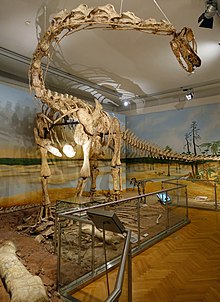| Spinophorosaurus Temporal range: Middle Jurassic,[1]
| |
|---|---|

| |
| 3D-printed reconstruction of the holotype skeleton in the Naturkundemuseum Braunschweig; the fossils on the floor are authentic | |
| Scientific classification | |
| Domain: | Eukaryota |
| Kingdom: | Animalia |
| Phylum: | Chordata |
| Clade: | Dinosauria |
| Clade: | Saurischia |
| Clade: | †Sauropodomorpha |
| Clade: | †Sauropoda |
| Clade: | †Gravisauria |
| Genus: | †Spinophorosaurus Remes et al., 2009 |
| Species: | †S. nigerensis
|
| Binomial name | |
| †Spinophorosaurus nigerensis Remes et al., 2009
| |
Spinophorosaurus is a genus of sauropod dinosaur that lived in what is now Niger during the Middle Jurassic period. The first two specimens were excavated in the 2000s by German and Spanish teams under difficult conditions. The skeletons were brought to Europe and digitally replicated, making Spinophorosaurus the first sauropod to have its skeleton 3D printed, and were to be returned to Niger in the future. Together, the two specimens represented most of the skeleton of the genus, and one of the most completely known basal sauropods of its time and place. The first skeleton was made the holotype specimen of the new genus and species Spinophorosaurus nigerensis in 2009; the generic name ("spine-bearing lizard") refers to what was initially thought to be spiked osteoderms, and the specific name (Niger and -ensis) refers to where it was found. A juvenile sauropod from the same area was later assigned to the genus.
The subadult holotype specimen is estimated to have been around 13 m (43 ft) in length, whereas the paratype was about 14 m (46 ft) long. The shoulder height reached by these individuals was estimated at around 4 m (13 ft), and the weight at about 7 metric tons (7.7 short tons). The braincase was short, deep, and broad, and the neuroanatomy was in some ways intermediate between that of basal sauropodomorphs and the more derived neosauropods. The teeth were spatulate (spoon shaped) and had large spaced denticles at the top of the crown, an ancestral feature in sauropods. The neck of Spinophorosaurus is one of the most completely known among sauropods, containing 13 vertebrae. The dorsal vertebrae had multiple small air-filled internal chambers, a feature typical of later more-derived sauropods. The tail was powered by strong musculature and had a rear section that was rather rigid due to long and overlapping chevron bones. Bones originally thought to be osteoderms bearing spikes placed on the tail tip were later suggested to be clavicles.
Spinophorosaurus has been classified as either a very basal sauropod, or inside Eusauropoda, a more derived group. The anatomy, age, and location of specimens indicate that important developments in sauropod evolution may have occurred in North Africa, possibly controlled by climatic zones and plant biogeography. Features of the vestibular apparatus suggest that vision and coordinated eye, head, and neck movements were important in Spinophorosaurus. 3D models of the skeleton have been used to test its range of motion. One study suggests it may have been a high browser, and another examined possible mating postures. Sutures between the neural arches with the centra of the vertebrae were more complex in the front part of the trunk of Spinophorosaurus, since stresses were probably greatest in that region. Spinophorosaurus is known from the Irhazer Shale, a geological formation thought to be Middle Jurassic in age. It was formed by deposits from rivers and lakes in a great river-valley system.